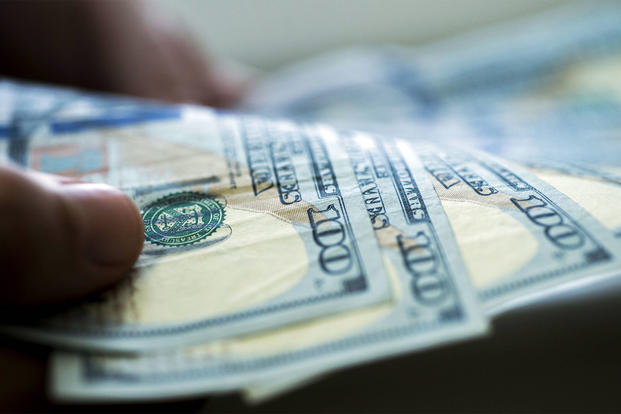Military Update: Basic Allowance for Housing (BAH) paid to 956,000 service members living off base in the U.S. will climb modestly Jan. 1, an average of only 0.7 percent or $10 a month, as an allowance-dampening formula enters its fourth year.
Actual BAH increases for individuals will vary widely based on where they are assigned, paygrade and whether they have family.
But military folks assigned to 128 of 301 of military housing areas will see no housing allowance increase in 2018 because local BAH rates will fall.
Related Content:
- Calculate your pay with the Military.com pay app.
- A 2.4% pay raise and higher Tricare pharmacy fees will hit in 2018
- Here are the GI Bill Changes Coming Soon
Thanks to a rate protection rule, no current recipients will see their BAH allowance fall in the new year, unless they move to a new locale, are demoted or they see their dependency status change.
"We do not penalize members who have already gone to a location, signed a lease and then rates happen to decrease," said Summer Britford, allowance branch chief for the Defense Travel Management Office in Alexandria, Virginia. "Incoming members do have access to lowered [rental] costs so they do experience those decreases."
Across 173 housing areas, stateside BAH rates will rise or be unchanged. Rates for 2018 can be in our military pay calculator.
BAH Rates Set Below Actual Housing Costs
For a fourth straight year, BAH adjustments will not quite keep pace with the rise of rents and utility costs because the Defense Department is implementing a five-year plan to hold down the cost of stateside housing allowances.
The dampening of rates by 1 percent a year will continue through 2019, when recipients will be paying 5 percent of off-base rental expenses out of pocket.
The 4 percent "absorption" rate in 2018 means monthly housing allowances will be $51 to $117 short of covering average rent and utility costs. The impact on individuals depends on rank, dependency status and assignment location. The range of out-of-pocket costs forecast for 2017 was $37 to $85 a month
Defense officials had urged Congress to allow dampening of BAH through next year so that millions of compensation dollars could be diverted to other readiness needs in tight times for defense budgets. Besides the plan to raise member out-of-pocket rental costs to 5 percent, officials saved another 1 percent on BAH, starting in 2015, by excluding rental insurance from rate calculations.
In the late 1990s, when BAH began, rates were set to cover 80 percent of average rental costs. Starting in 2000, BAH funding grew. By 2005, the 20 percent absorption rate had been eliminated. Through 2014, average BAH fully had covered members' rental expenses.
Even as the relative value of BAH falls, officials point out that members can control out-of-pocket costs based on rental choices. Rates are set so that members who rent median-priced properties will pay a small amount out of pocket. Those who elect to economize in housing choices can find units their BAH will fully cover.
How BAH Rates Are Calculated
In 2018, BAH payments will total $20.9 billion, said Britford. Average BAH nationwide will be $1,839 for members with dependents and $1,493 for members without dependents.
Rates are reset annually based on median market rents and average utility costs (electricity, heat, water and sewer) for six housing profiles -- a combination of dwelling type (apartments, townhouses, single-family homes) and number of bedrooms. Individual rates reflect local costs for the type of housing deemed appropriate for a member based on paygrade and dependency status.
Fresh cost data for adjusting rates are collected in two ways, Britford said.
Every military housing office in the field provides rental cost information for adequate and available properties in their communities. Also, economic consulting firm Robert D. Niehaus Inc., or RDN, collects nationwide cost data for the six different housing types and bedroom numbers in every military housing area.
The goal is data for 70 units of every housing type in every area. The RDN surveys won't include neighborhoods identified by census tract data or military housing offices as inadequate. Utility costs are calculated using other survey data of what civilians in each housing area and housing profile spend on utilities.
The 2018 BAH Winners and Losers
The typical mid-grade enlisted with dependents will see their BAH rise Jan. 1 by $19 per month and a typical junior officer without dependents by $16.
Fort Wayne, Indiana, where only 206 BAH recipients reside, will see a 15 percent average increase in BAH, the largest of any housing area. Almost 3,800 BAH recipients at Beale Air Force Base, California, and 2,900 at Mountain Home Air Force Base, Idaho, will see their allowance pop by an average of 11 percent.
BAH recipients will be particularly thankful for rate protection in other areas. Rates will fall an average of 10 percent in Minot, North Dakota, where 4,800 service members are assigned, but their own payments will stay steady. Average BAH will fall 9 percent at Fort Knox, Kentucky, and in New York City, but only for new arrivals.
Changes in BAH can vary widely even within the same state.
Rates will drop an average of 7.5 percent in Montgomery, Alabama, but rise by 0.7 percent in Huntsville. Rates will climb an average of 7.7 percent at Barstow/Fort Irwin and 7.5 percent at Edward Air Force Base/Palmdale, California, and fall 7.2 percent in Panama City and 3 percent in Pensacola, Florida.
Some areas with larger bases where BAH will rise include: Joint Base McGuire-Dix-Lakehurst, New Jersey (5.7 percent); Albuquerque/Kirtland AFB, New Mexico (5.8); Beaufort/Parris Island, South Carolina (7.0); Bremerton (6.0) and Tacoma, Washington (5.5).
Areas where rates will fall include: Fort Riley, Kansas (-4.3); Shreveport/Barksdale AFB (-3.1); Camp Lejeune, North Carolina (-5.7); Fort Bragg/Pope Air Force Base (-2.3); Trenton, New Jersey (-5.9) and Hampton/Newport News, Virginia. (-2.1)
More information on BAH, including a rate component breakdown, is available online.
Overseas Housing Allowances (OHA) for the military are calculated differently than is BAH, Britford said. OHA is based on what members actually pay to rent housing overseas. It's reviewed every six months and also gets adjusted to keep pace with the dollar's changing value against local currency. The utility allowance is reviewed and adjusted annually and a "move-in" allowance every three years.
To comment, write Military Update, P.O. Box 231111, Centreville, VA, 20120 or email milupdate@aol.com or twitter: @Military_Update.
# # # #
Tom Philpott has been breaking news for and about military people since 1977. After service in the Coast Guard, and 17 years as a reporter and senior editor with Army Times Publishing Company, Tom launched "Military Update," his syndicated weekly news column, in 1994. "Military Update" features timely news and analysis on issues affecting active duty members, reservists, retirees and their families. Visit Tom Philpott's Military Update Archive to view his past articles. Tom also edits a reader reaction column, "Military Forum." The online home for both features is Military.com.
 Tom's freelance articles have appeared in numerous magazines including The New Yorker, Reader's Digest and Washingtonian. His critically-acclaimed book, Glory Denied, on the extraordinary ordeal and heroism of Col. Floyd "Jim" Thompson, the longest-held prisoner of war in American history, is available in hardcover and paperback. Buy Glory Denied from Amazon
Tom's freelance articles have appeared in numerous magazines including The New Yorker, Reader's Digest and Washingtonian. His critically-acclaimed book, Glory Denied, on the extraordinary ordeal and heroism of Col. Floyd "Jim" Thompson, the longest-held prisoner of war in American history, is available in hardcover and paperback. Buy Glory Denied from Amazon





